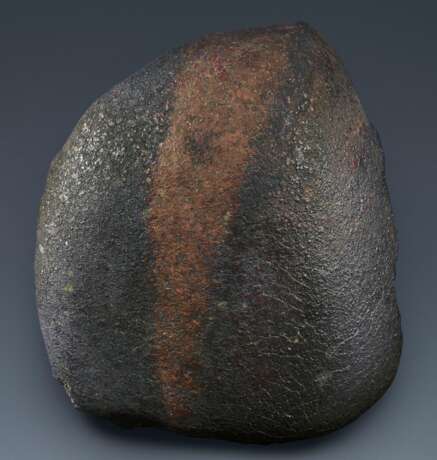ID 389956
Lot 13 | NWA 13201 — RARE MASSIVE ORIENTED METEORITE
Valeur estimée
$ 40 000 – 60 000
This is a perfectly parabolic oriented meteorite. It is covered in a thin veneer of crust, the result from surface melting during atmospheric passage, except for a couple of small chips and from where the classification repository sample was removed on the reverse. Both provide a window to this meteorite’s internal matrix where a scattering of inclusions and suspended metallic flakes are evident. An ochre patch running the length of this ellipsoid-shaped specimen indicates the depth of penetration into the ground. A faint ablation lip runs along the reverse of the perimeter. Evoking primitive art or a tribal artifact, as well as the sacred Roman Elagabalus stone, this is a singular oriented meteorite.
314 x 268 x 117mm (12.5 x 10.66 x 4.66 in.)
18.97kg (41.75 lbs)
Provenance: Macovich Collection of Meteorites, New York City
Amongst the finest large examples of an oriented meteorite known. Unlike 99% of all meteorites, this meteorite possesses a rare distinction: it’s oriented, which is to say it did not tumble or invert as it descended through Earth’s atmosphere; it maintained the same axis of orientation during its earthward plunge. Its name is the result of it being the 13,201st meteorite to be recovered from the North West African corridor of the Sahara Desert to be analyzed, classified and published. Meteorite specimens become oriented as a result of the fortuitous distribution of their mass after fragmentation in the atmosphere. The parabolic "heat shield" curvature seen here was naturally sculpted as a result of frictional heating with Earth’s atmosphere. Significantly, the curve in evidence is the most efficient angle at which heat is deflected when an object is undergoing frictional heating as it penetrates the atmosphere. As such, the ablative heat shields for the first manned space capsules were inspired and emulated from oriented meteorites similar to the current offering, which itself evokes a tribal shield.
Christie's would like to thank Dr. Alan E. Rubin at the Institute of Geophysics and Planetary Physics, University of California, Los Angeles for his assistance in preparing this catalogue.
| Adresse de l'enchère |
CHRISTIE'S 8 King Street, St. James's SW1Y 6QT London Royaume-Uni | |
|---|---|---|
| Aperçu |
| |
| Téléphone | +44 (0)20 7839 9060 | |
| Commission | see on Website | |
| Conditions d'utilisation | Conditions d'utilisation |



